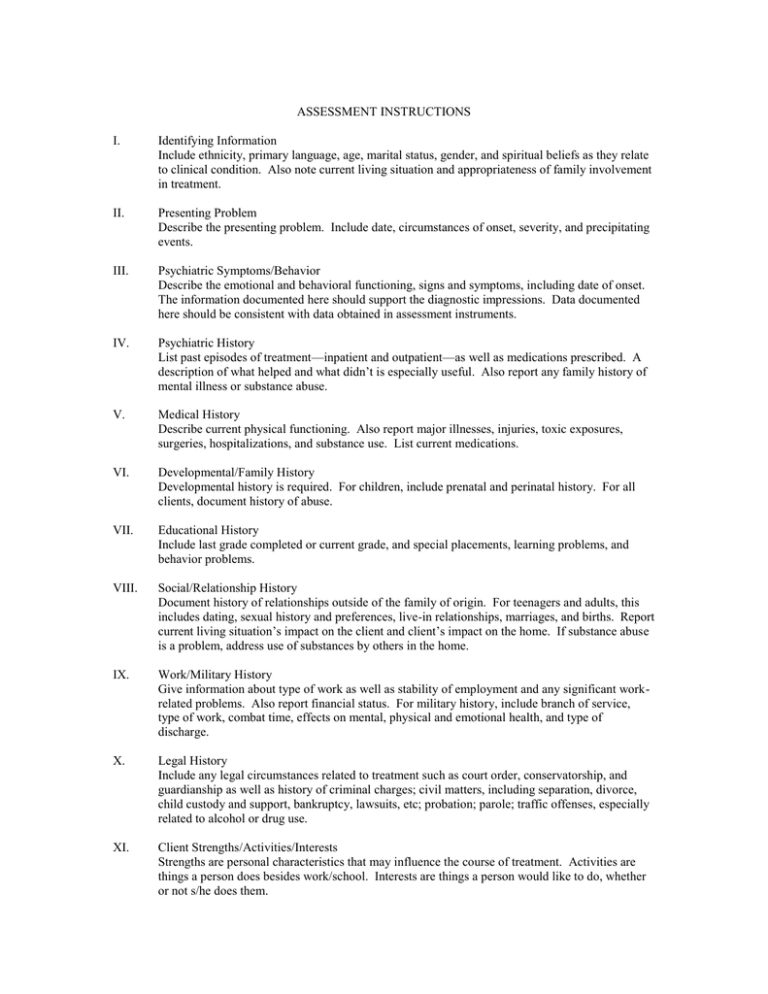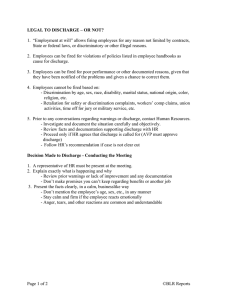Assessment Instructions
advertisement

ASSESSMENT INSTRUCTIONS I. Identifying Information Include ethnicity, primary language, age, marital status, gender, and spiritual beliefs as they relate to clinical condition. Also note current living situation and appropriateness of family involvement in treatment. II. Presenting Problem Describe the presenting problem. Include date, circumstances of onset, severity, and precipitating events. III. Psychiatric Symptoms/Behavior Describe the emotional and behavioral functioning, signs and symptoms, including date of onset. The information documented here should support the diagnostic impressions. Data documented here should be consistent with data obtained in assessment instruments. IV. Psychiatric History List past episodes of treatment—inpatient and outpatient—as well as medications prescribed. A description of what helped and what didn’t is especially useful. Also report any family history of mental illness or substance abuse. V. Medical History Describe current physical functioning. Also report major illnesses, injuries, toxic exposures, surgeries, hospitalizations, and substance use. List current medications. VI. Developmental/Family History Developmental history is required. For children, include prenatal and perinatal history. For all clients, document history of abuse. VII. Educational History Include last grade completed or current grade, and special placements, learning problems, and behavior problems. VIII. Social/Relationship History Document history of relationships outside of the family of origin. For teenagers and adults, this includes dating, sexual history and preferences, live-in relationships, marriages, and births. Report current living situation’s impact on the client and client’s impact on the home. If substance abuse is a problem, address use of substances by others in the home. IX. Work/Military History Give information about type of work as well as stability of employment and any significant workrelated problems. Also report financial status. For military history, include branch of service, type of work, combat time, effects on mental, physical and emotional health, and type of discharge. X. Legal History Include any legal circumstances related to treatment such as court order, conservatorship, and guardianship as well as history of criminal charges; civil matters, including separation, divorce, child custody and support, bankruptcy, lawsuits, etc; probation; parole; traffic offenses, especially related to alcohol or drug use. XI. Client Strengths/Activities/Interests Strengths are personal characteristics that may influence the course of treatment. Activities are things a person does besides work/school. Interests are things a person would like to do, whether or not s/he does them. XII. Other Relevant Data Note pertinent information not documented elsewhere. Include liabilities, e.g. barriers to treatment, potential relapse triggers, and past difficulties in treatment or in maintaining recovery. XIII. Mental Status Exam Mental status is a description of functioning at one point in time – the time it is assessed. Include appearance, behavior, speech, orientation, affect, mood, thought content, intellectual functioning, insight, judgement, suicidality, and homicidality. XIV. Diagnostic Impressions Use the current DSM and cover all five axes. Include a prognosis. XV. Treatment Recommendations Give a preliminary treatment plan, including problems that need to be addressed such as problems with finances, housing, social support, and legal matters. Indicate appropriate level of care. XVI. Preliminary Discharge Plan Report anticipated discharge criteria as well as planned treatment following discharge from the current level of care. Document any anticipated problems in discharge to a lower level of care. 9/3/98


